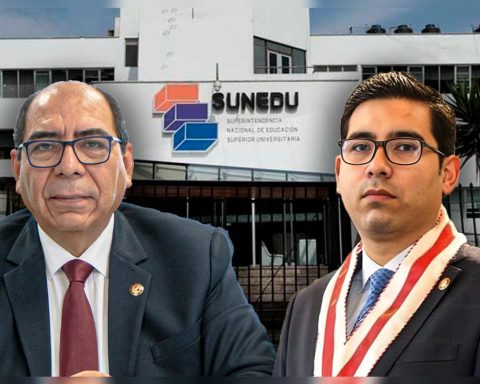Mabel Careaga, daughter of Esther Ballestrino, one of the founders of the Mothers of the Plaza de Mayo and a member of the group “the 12 of the Holy Cross” -the group of mothers and relatives of the disappeared who were victims of an operation by the Joint Forces in December 1977 in the Church of the Holy Cross-, described his mother as a “symbol of the collective struggle” that despite “the not having managed to defeat death, he managed to overcome oblivion”, defeating with “his white handkerchief the rifles of the dictatorship”.
“My mother was a revolutionary with a strong social commitment, she always told me that I had to feel the pain of the other as if it were my own”Careaga expressed in an interview with Télam a few days after the 45th anniversary of those dramatic episodes in which the Mothers of Plaza de Mayo Azucena Villaflor and María Ponce de Bianco were also kidnapped.
Esther had been “dodging the military for a while”: first, she escaped from the Paraguayan dictatorship of Higinio Morínigo; then, once settled in Argentina, she hosted several compatriots who were escaping from the dictator Alfredo Stroessner and a few years later she “would face with her white handkerchief” the Argentine State terrorism commanded by Jorge Rafael Videla.
“We received many Paraguayan exiles who sought refuge in Argentina, my house was a place of passage; they stayed for a while, told what was happening in Paraguay, the torture. I was only 10 years old and I already knew what the submarine was. wet or the dry submarine”, Mabel recalled about her childhood in a home where “solidarity and the political question” were common currency.
On September 13, 1976, Mabel was three months pregnant when her partner, Manuel Carlos Cuevas, was kidnapped, at which time Esther would join forces with her mother-in-law Gerónima Cuevas to try to find his whereabouts, still unknown today.
“On July 13, 1977, my younger sister Ana María, who was also pregnant, was kidnapped, and from then on, everything my mother had been doing with the group of Mothers of Plaza de Mayo and Relatives of the Disappeared and Detained for Political Reasons intensifies it much more”, Mabel recounted about the case of her sister, who after three months incarcerated in the clandestine detention center “El Atlético” was “miraculously released without losing her baby”. .
Mabel recalled that the same night that her sister met them again at her home in Castelar and recounted everything that had happened, she spoke of the fact that at Atlético she had seen the lawyer Teresa Israel alive – who had presented the habeas corpus petition for her colleague. Mabel- and whose mother Clara was very close to Esther for being part of the group of Relatives of the Disappeared.
“Without hesitation, my mother insisted on going at that very moment in the middle of the night from Castelar to Parque Centenario to notify her family, arguing that ‘Clarita cannot spend one more night without knowing that her daughter is alive,’ and so on. we did it”recounted Careaga and highlighted: “Those things my mother had, solidarity and an exceptional ability to put herself in the other’s place.”
Then the moment of exile would come.
Ana María, pregnant and along with her partner, and Mabel arrived in Rio de Janeiro to travel to Sweden after seeking refuge at the United Nations.

One day before the flight to Sweden leaves, Esther went to Brazil to meet her daughters to take Carlitos, Mabel’s few-month-old son.
“That is the last image of my mother that I have etched strongly in my memory, she walking on the beach of Rio (de Janeiro) with a yellow baton and a t-shirt on my head because of the heat it was with my son in my arms coming towards me”, Mabel recalled, straining with her eyes closed, as if she still saw her coming.
There was no way to convince Esther to go into exile as well until “the waters calmed down”; She returned and answered the group of Mothers who questioned her permanence having recovered her daughter: “I’ll stay until they all show up, because all the disappeared are my children.”
“That was the determination that she had, it took me a long time to understand it, but it was her life, she had always been like that, it was her essence and she was not going to change at that moment,” Mabel reflected on it.
Kidnapping
On December 8, 1977, Mabel met in the Church of the Holy Cross, as she had been doing, with the rest of the relatives of the disappeared and other collaborators with the cause, to raise funds to publish the request for December 10 that said ” For a peaceful Christmas, we only ask for the truth.”
“Before that I have one last letter from my mother where she tells me in code ‘we know that there are many tourists who are in the South for the summer and that already tired of spending the summer they are going to return home for Christmas'”.
“What he was saying was that there were many missing people alive and that they were waiting for them to be released by Christmas, within this framework they plan the request,” Mabel revealed.
There were five operations in total between December 8 and 10, 1977 where they kidnapped “the 12 of the Holy Cross”, as they called themselves at the Navy Mechanics School (ESMA), where they remained between 4 and 6 days and then, on December 14, they were dragged onto one of the “death flights.”
The Careaga sisters had only two calls during their first period of exile: they used the first to let them know that they had arrived safely in Sweden; the second was used on December 11, 1977 to announce that Anita, Ana María’s daughter, had been born.
In that same call they found out that their mother had been kidnapped.
Twenty-eight years passed until the Careaga family was able to learn the truth and recover Esther’s remains thanks to the concern of a group of students from the University of La Plata (UNLP) who investigated the apparition between December 1977 and January 1978. of five bodies on the shores of Santa Teresita.
“All of Santa Teresita knew but no one ever asked or talked about it. Everything was documented, the bodies had appeared, the firefighters had picked them up, they had taken them to the morgue, they had issued a death certificate and they had buried them as NN in the General Lavalle cemetery,” explained Mabel.
This discovery and verification of identity thanks to the work carried out by the Argentine Forensic Anthropology Team (EAAF) was the first scientific proof of the existence of death flights.
“Going through all that was very hard, but in my case I felt that I had not even left my mother’s remains to the dictatorship, that I had recovered them and that we had given them a name and that she was with us again.”Mabel tried to express in words about the moment in which she received confirmation that one of those “bodies that the sea had returned for justice to be done was that of her mother.”
He shared that “when they appeared we always say that they could not against death but they could against oblivion, it is a phrase that helps us as a family.”
The family decision to bury Esther’s remains in the garden of the Church of the Holy Cross was a suggestion, according to Mabel, from the Grandmother of Plaza de Mayo Alba Lanzillotto, when she told them that this place was “the last free land they stepped on “.
“My mother was a symbol of the collective struggle, of not thinking only of her and her daughter but of the 30,000 and that made us think that she deserved to be in a collective place to remember her,” said Mabel.
“I always keep in mind the strength and courage of that group of mothers who, despite what happened that December 1977, returned to the Plaza de Mayo, linked arms and never left again, with their white handkerchiefs they defeated the rifles of the dictatorship”, he concluded.


















